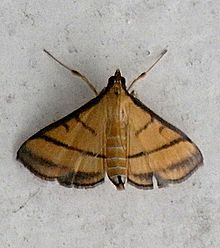Rice leafroller facts for kids
Quick facts for kids Rice leafroller |
|
|---|---|
 |
|
| Scientific classification | |
| Kingdom: | |
| Phylum: | |
| Class: | |
| Order: | |
| Family: | |
| Genus: |
Cnaphalocrocis
|
| Species: |
C. medinalis
|
| Binomial name | |
| Cnaphalocrocis medinalis (Guenée, 1854)
|
|
| Synonyms | |
|
|
The rice leafroller (scientific name: Cnaphalocrocis medinalis) is a small moth. It belongs to the Crambidae family. You can find these moths in many parts of south-east Asia. This includes places like Hong Kong, Sri Lanka, Taiwan, Thailand, and most of Australia.
This moth is known as a pest. Its young form, called a larva or caterpillar, eats important crops. These crops include rice, corn, wheat, sugarcane, and sorghum.
Contents
What Does a Rice Leafroller Look Like?
The adult moth is very active. It is bright yellow or straw-colored. Its front wings have two wavy lines. The back wings have one wavy line. The moth's wingspan is about 15 millimeters (0.6 inches) wide.
Life Cycle of the Rice Leafroller
The rice leafroller goes through several stages in its life.
Eggs
The moth lays its eggs one by one or in small groups. They are placed in rows on the underside of leaves. The eggs are scaly white and shaped like a flat oval. They are about 1 millimeter (0.04 inches) long. When first laid, they are milky white. Later, they turn yellow-brown. A black spot appears just before they hatch. A female moth can lay about 56 eggs. The eggs hatch in 4 to 8 days.
Larvae (Caterpillars)
After hatching, the eggs turn into larvae, also known as caterpillars. Most larvae go through 5 stages of growth. When fully grown, they are about 15-18 millimeters (0.6-0.7 inches) long. Their heads are brown. Their bodies are green at first, then become yellowish-green. When they are ready to change, they turn reddish-brown.
These caterpillars have special markings. They have two spiral black lines on their front body part. They also have eight small black circles on their middle and back body parts. The larval stage lasts about 22 to 23 days.
Pupae
After the larval stage, the caterpillar changes into a pupa. It usually forms its pupa inside a folded leaf. The pupa is about 9 millimeters (0.35 inches) long. It has a white, thin cocoon. This stage lasts about 6 to 7 days.
Adults
The adult moth is about 7-9 millimeters (0.28-0.35 inches) long. Its wingspan is about 13-18 millimeters (0.5-0.7 inches). Male moths have a shiny, sunken spot on their front wings. Female moths do not have this spot. The total life cycle, from egg to adult, takes about 5 weeks.
Why Are Rice Leafrollers a Problem?
Rice leafrollers cause damage mainly when they are larvae. They are a big problem for rice crops. Rice is a very important food for more than half the people in the world.
How They Damage Plants
When a caterpillar hatches, it cuts the edges of a leaf and folds it. If young plants are attacked, the caterpillar folds 3 or 4 leaves together. It then scrapes off the green parts of the leaves. This makes the damaged leaves look white.
One caterpillar can damage many leaves. The attacked plants become weak and dry up. This greatly reduces the amount of crop that can be harvested. Farmers can lose 10% to 50% of their crop because of these pests. The damage is worst when the rice plants are in the "boot leaf stage" (when the plant is getting ready to flower).
A single larva can eat about 25 square centimeters (4 square inches) of leaf. This is less than half of a normal rice leaf. Younger larvae crawl into the heart of the leaf or nearby leaf sheath. Older larvae (4th and 5th stage) eat more than 90% of the total food consumed by the caterpillar.
How to Control Rice Leafrollers
Farmers use different methods to control these pests.
Farming Methods
Farmers can change how they grow rice. They can use different planting times and avoid planting early, middle, and late rice together. This helps reduce the number of leafrollers. They can also choose certain types of rice plants that are less likely to be damaged. Harvesting early can also help kill some larvae and pupae. This reduces the number of pests in the next generation.
Physical Control
Rice leafrollers are attracted to light. Farmers can use special lamps to attract and kill the moths. These "lure insect lamps" are quick and effective. They do not need chemicals and do not pollute the environment.
Natural Control
Using too many chemicals can make pests resistant to them. It can also kill helpful insects that eat the leafrollers. There are more than 130 natural enemies of the rice leafroller. Protecting these natural predators is important for keeping the pests under control in a healthy way.
Chemical Control
Some special crops, like Bt crops, can help. Farmers can also use pesticides. They should use different types of pesticides at different times. This stops the rice leafrollers from becoming resistant to any one chemical.


